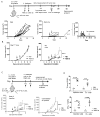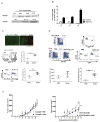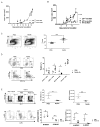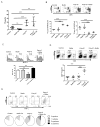Local Activation of p53 in the Tumor Microenvironment Overcomes Immune Suppression and Enhances Antitumor Immunity
- PMID: 28280037
- PMCID: PMC5465961
- DOI: 10.1158/0008-5472.CAN-16-2832
Local Activation of p53 in the Tumor Microenvironment Overcomes Immune Suppression and Enhances Antitumor Immunity
Abstract
Mutations in tumor suppressor p53 remain a vital mechanism of tumor escape from apoptosis and senescence. Emerging evidence suggests that p53 dysfunction also fuels inflammation and supports tumor immune evasion, thereby serving as an immunological driver of tumorigenesis. Therefore, targeting p53 in the tumor microenvironment (TME) also represents an immunologically desirable strategy for reversing immunosuppression and enhancing antitumor immunity. Using a pharmacological p53 activator nutlin-3a, we show that local p53 activation in TME comprising overt tumor-infiltrating leukocytes (TILeus) induces systemic antitumor immunity and tumor regression, but not in TME with scarce TILeus, such as B16 melanoma. Maneuvers that recruit leukocytes to TME, such as TLR3 ligand in B16 tumors, greatly enhanced nutlin-induced antitumor immunity and tumor control. Mechanistically, nutlin-3a-induced antitumor immunity was contingent on two nonredundant but immunologically synergistic p53-dependent processes: reversal of immunosuppression in the TME and induction of tumor immunogenic cell death, leading to activation and expansion of polyfunctional CD8 CTLs and tumor regression. Our study demonstrates that unlike conventional tumoricidal therapies, which rely on effective p53 targeting in each tumor cell and often associate with systemic toxicity, this immune-based strategy requires only limited local p53 activation to alter the immune landscape of TME and subsequently amplify immune response to systemic antitumor immunity. Hence, targeting the p53 pathway in TME can be exploited to reverse immunosuppression and augment therapeutic benefits beyond tumoricidal effects to harness tumor-specific, durable, and systemic antitumor immunity with minimal toxicity. Cancer Res; 77(9); 2292-305. ©2017 AACR.
©2017 American Association for Cancer Research.
Figures







Similar articles
-
Immunomodulatory Function of the Tumor Suppressor p53 in Host Immune Response and the Tumor Microenvironment.Int J Mol Sci. 2016 Nov 19;17(11):1942. doi: 10.3390/ijms17111942. Int J Mol Sci. 2016. PMID: 27869779 Free PMC article. Review.
-
Inhibition of Rspo-Lgr4 Facilitates Checkpoint Blockade Therapy by Switching Macrophage Polarization.Cancer Res. 2018 Sep 1;78(17):4929-4942. doi: 10.1158/0008-5472.CAN-18-0152. Epub 2018 Jul 2. Cancer Res. 2018. PMID: 29967265
-
Sorafenib relieves cell-intrinsic and cell-extrinsic inhibitions of effector T cells in tumor microenvironment to augment antitumor immunity.Int J Cancer. 2014 Jan 15;134(2):319-31. doi: 10.1002/ijc.28362. Epub 2013 Jul 30. Int J Cancer. 2014. PMID: 23818246
-
Isolation of immune cells from primary tumors.J Vis Exp. 2012 Jun 16;(64):e3952. doi: 10.3791/3952. J Vis Exp. 2012. Retraction in: J Vis Exp. 2016 Mar 10;(109). doi: 10.3791/5776. PMID: 22733225 Free PMC article. Retracted.
-
The Tumor Microenvironment in the Response to Immune Checkpoint Blockade Therapies.Front Immunol. 2020 May 7;11:784. doi: 10.3389/fimmu.2020.00784. eCollection 2020. Front Immunol. 2020. PMID: 32457745 Free PMC article. Review.
Cited by
-
Predictive Biomarkers for Immune-Checkpoint Inhibitor Treatment Response in Patients with Hepatocellular Carcinoma.Int J Mol Sci. 2023 Apr 21;24(8):7640. doi: 10.3390/ijms24087640. Int J Mol Sci. 2023. PMID: 37108802 Free PMC article. Review.
-
Tumor Mutation Burden, Immune Cell Infiltration, and Construction of Immune-Related Genes Prognostic Model in Head and Neck Cancer.Int J Med Sci. 2021 Jan 1;18(1):226-238. doi: 10.7150/ijms.51064. eCollection 2021. Int J Med Sci. 2021. PMID: 33390791 Free PMC article.
-
Restoration of p53 activity via intracellular protein delivery sensitizes triple negative breast cancer to anti-PD-1 immunotherapy.J Immunother Cancer. 2022 Sep;10(9):e005068. doi: 10.1136/jitc-2022-005068. J Immunother Cancer. 2022. PMID: 36104100 Free PMC article.
-
MDM2- an indispensable player in tumorigenesis.Mol Biol Rep. 2023 Aug;50(8):6871-6883. doi: 10.1007/s11033-023-08512-3. Epub 2023 Jun 14. Mol Biol Rep. 2023. PMID: 37314603 Free PMC article. Review.
-
MDM2 inhibitors in cancer immunotherapy: Current status and perspective.Genes Dis. 2024 Mar 28;11(6):101279. doi: 10.1016/j.gendis.2024.101279. eCollection 2024 Nov. Genes Dis. 2024. PMID: 39263534 Free PMC article. Review.
References
MeSH terms
Substances
Grants and funding
LinkOut - more resources
Full Text Sources
Other Literature Sources
Molecular Biology Databases
Research Materials
Miscellaneous

